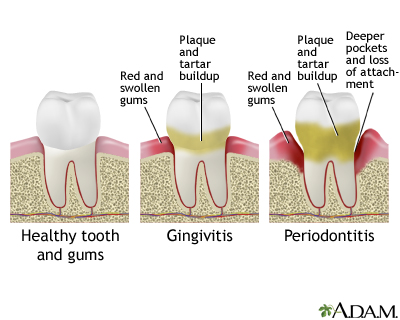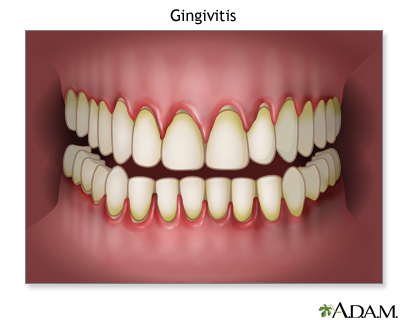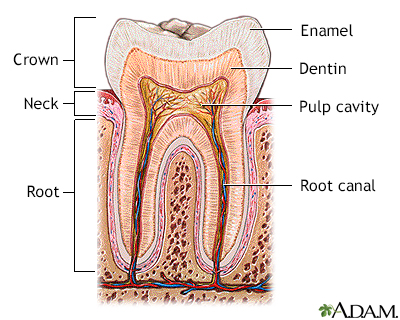Periodontitis
Pyorrhea - gum disease; Inflammation of gums - involving bone
Periodontitis is inflammation and infection of the ligaments and bones that support the teeth.
Images



I Would Like to Learn About:
Causes
Periodontitis is a chronic infection of the gums that occurs when gum inflammation (gingivitis) is not treated. The infection worsens over time, causing breakdown and loss of the ligaments, soft tissues, and bone (supporting structures) of your teeth. This loss of support causes the teeth to become loose and eventually fall out. Periodontitis is the primary cause of tooth loss in adults. This disorder is uncommon in young children, but it increases during the teen years.
Plaque and tartar build up on the teeth. Inflammation results from this buildup and causes a normal “sulcus” to deepen into an abnormal "pocket," or gap between the gums and the teeth below the gum line. This pocket collects more plaque and transforms into a hard material called tartar. The bacteria in the plaque and tartar get trapped in the pockets and receive less oxygen. These anaerobes trigger the body’s inflammatory response, which leads to the natural destruction of the support for your teeth. Periodontal disease is a painless, chronic inflammatory disease, which if not treated, often leads to tooth mobility and tooth loss
Symptoms
Symptoms of periodontitis include:
- Bad breath odor (halitosis)
- Gums that are bright red or reddish-purple
- Gums that look shiny
- Gums that bleed easily (when flossing or brushing)
- Gums that are tender when touched but are painless otherwise
- Gums that have receded
- Loose teeth
- Swollen gums
- Gaps between the teeth and gums
- Shifting teeth
- Yellow, brown green or white hard deposits on your teeth
- Tooth sensitivity
Note: Early symptoms are similar to gingivitis (inflammation of the gums).
Exams and Tests
Your dentist will examine your mouth and teeth. Your gums will be soft, swollen, and reddish-purple. (Healthy gums are pink and firm.) You may have plaque and tartar at the base of your teeth, and the pockets in your gums may be enlarged. In most cases, the gums are painless or only mildly tender, unless a tooth abscess is also present. Your gums will be tender when checking your pockets with a probe. Your teeth may be loose and gums may be pulled back, exposing the base of your teeth.
Dental x-rays show the loss of supporting bone. They may also show tartar deposits under your gums.
Treatment
The goal of treatment is to reduce inflammation, remove pockets in your gums, and treat any underlying causes of gum disease.
Rough surfaces of teeth or dental appliances should be repaired.
Have your teeth cleaned thoroughly. This may involve the use of various tools to loosen and remove plaque and tartar from your teeth. Flossing and brushing is always needed to reduce your risk for gum disease, even after professional tooth cleaning. Your dentist or dental hygienist will show you how to brush and floss properly. You may benefit from medicines that are put directly on your gums and teeth. People with periodontitis should have a professional teeth cleaning every 3 months.
Surgery may be needed to:
- Open and clean deep pockets in your gums
- Build support for loose teeth
- Remove a tooth or teeth so that the problem doesn't get worse and spread to nearby teeth
Outlook (Prognosis)
Some people find the removal of dental plaque from inflamed gums to be uncomfortable. You may need to be numb during this process. Bleeding and tenderness of the gums should go away within 3 to 4 weeks of treatment.
You need to perform careful home brushing and flossing for your entire life so that the problem does not return.
Possible Complications
These complications can occur:
- Infection or abscess of the soft tissue
- Infection of the jaw bones
- Return of periodontitis
- Tooth abscess
- Tooth loss
- Tooth flaring (sticking out) or shifting
- Trench mouth
When to Contact a Medical Professional
See your dentist if you have signs of gum disease.
Prevention
Good oral hygiene is the best way to prevent periodontitis. This includes thorough tooth brushing and flossing, and regular professional dental cleaning. Preventing and treating gingivitis reduces your risk of developing periodontitis.
Related Information
GingivitisTooth abscess
Cellulitis
Osteomyelitis
Trench mouth
References
Chow AW. Infections of the oral cavity, neck, and head. In: Bennett JE, Dolin R, Blaser MJ, eds. Mandell, Douglas and Bennett's Principles and Practice of Infectious Diseases. 9th ed. Philadelphia, PA: Elsevier; 2020:chap 64.
Dommisch H, Kebschull M. Periodontitis. In: Newman MG, Klokkevold PR, Elangovan S, Hemandez-Kapila YL, eds. Newman and Carranza's Clinical Periodontology and Implantology. 14th ed. Philadelphia, PA: Elsevier; 2023:chap 21.
Pedigo RA. Oral medicine. In: Walls RM, ed. Rosen's Emergency Medicine: Concepts and Clinical Practice. 10th ed. Philadelphia, PA: Elsevier; 2023:chap 56.
Simon L, Silk H. Diseases of the mouth. In: Kellerman RD, Rakel DP, Heidelbaugh JJ, Lee EM, eds. Conn's Current Therapy 2024. Philadelphia, PA: Elsevier; 2024:1093-1098.
BACK TO TOPReview Date: 3/31/2024
Reviewed By: Michael Kapner, DDS, General Dentistry, Norwalk Medical Center, Norwalk CT. Review provided by VeriMed Healthcare Network. Also reviewed by David C. Dugdale, MD, Medical Director, Brenda Conaway, Editorial Director, and the A.D.A.M. Editorial team.

Health Content Provider
06/01/2025
|
A.D.A.M., Inc. is accredited by URAC, for Health Content Provider (www.urac.org). URAC's accreditation program is an independent audit to verify that A.D.A.M. follows rigorous standards of quality and accountability. A.D.A.M. is among the first to achieve this important distinction for online health information and services. Learn more about A.D.A.M.'s editorial policy, editorial process and privacy policy. A.D.A.M. is also a founding member of Hi-Ethics. This site complied with the HONcode standard for trustworthy health information from 1995 to 2022, after which HON (Health On the Net, a not-for-profit organization that promoted transparent and reliable health information online) was discontinued. |
The information provided herein should not be used during any medical emergency or for the diagnosis or treatment of any medical condition. A licensed medical professional should be consulted for diagnosis and treatment of any and all medical conditions. Links to other sites are provided for information only -- they do not constitute endorsements of those other sites. © 1997- 2025 A.D.A.M., a business unit of Ebix, Inc. Any duplication or distribution of the information contained herein is strictly prohibited.
